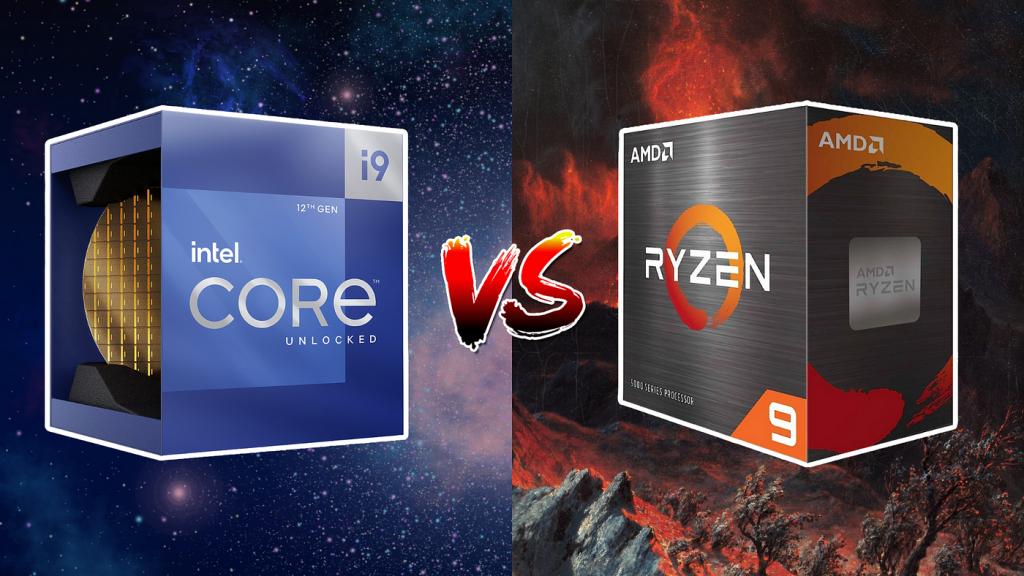In modern computing, energy efficiency is just as vital as performance. Power-hungry processors can cause overheating, raise electricity costs, and reduce system stability, especially under heavy workloads. As such, comparing CPU power usage, understanding Ryzen vs Intel wattage, and analyzing thermal output is critical for both everyday users and professionals building high-performance rigs.

Why CPU Power Efficiency Matters
When evaluating a processor, users should not only focus on raw performance but also on how efficiently that power is used. Factors such as heat output, energy consumption under load, and cooling requirements directly impact:
-
System stability
-
Operating costs
-
Component longevity
-
Acoustic performance (fan noise)
-
Battery life in laptops
In this article, we’ll evaluate the two giants of CPU manufacturing—AMD Ryzen and Intel Core—through the lens of power efficiency and thermal output.
Power Consumption Specifications: Intel vs Ryzen
Both companies follow different philosophies in managing power draw and performance.
Intel Core (14th Gen – Raptor Lake Refresh)
-
Base TDP: 125W (for i7/i9 K-series)
-
Maximum Turbo Power: Up to 253W
-
Utilizes Performance (P) and Efficiency (E) cores for hybrid architecture
-
Aggressive boost frequencies at the cost of high wattage
AMD Ryzen (7000 Series)
-
Base TDP: 65W to 170W (depending on model)
-
Max Package Power (PPT): ~230W (for Ryzen 9 7950X)
-
Focus on balanced performance-per-watt
-
3D V-Cache variants offer lower power usage and thermal loads
Real-World CPU Power Usage Comparison
| CPU Model | Idle Power Usage | Average Load (Gaming) | Peak Load (Rendering) | Max TDP |
|---|---|---|---|---|
| Intel Core i9-14900K | ~30W | ~180W | ~253W | 253W |
| AMD Ryzen 9 7950X | ~27W | ~125W | ~230W | 170W |
| Intel Core i7-14700K | ~28W | ~150W | ~215W | 253W |
| AMD Ryzen 7 7700X | ~22W | ~105W | ~170W | 105W |
Observation: Intel CPUs generally consume more power under load, especially during rendering and multi-core tasks, while AMD processors offer a more controlled and consistent power envelope.
Thermal Output and Cooling Demands
Intel:
-
Runs hotter under load, often hitting 90–100°C.
-
Needs high-end liquid cooling for consistent boost performance.
-
Thermal throttling risk increases in compact cases.
AMD:
-
Better thermal regulation, especially with 3D V-Cache models.
-
Compatible with standard air coolers in many cases.
-
Generates less fan noise under extended use.
Platform Efficiency and Energy Optimization
| Feature | Intel (LGA1700) | AMD (AM5) |
|---|---|---|
| Socket Longevity | Limited to 13th/14th Gen | AM5 platform supported beyond 2026 |
| Chipset Efficiency | Higher idle draw from motherboards | Lower power draw across X670/B650 |
| RAM Compatibility | DDR4 + DDR5 | DDR5 only |
| Overclocking Headroom | Available but hot | Efficient with Precision Boost Overdrive |
AMD’s Smart Access Memory (SAM) and Eco Mode offer unique tuning capabilities that reduce total system power draw with minimal performance loss, appealing to eco-conscious users and creators running 24/7 systems.
Laptop Considerations: Ryzen vs Intel Efficiency
In mobile platforms, Ryzen CPUs dominate battery life benchmarks. The Ryzen 7000 mobile series (Zen 4) features efficient cores that extend usage time without compromising performance.
Mobile Performance Highlights
| Processor | Battery Life (Web Browsing) | Thermal Throttle Risk | Performance Efficiency |
|---|---|---|---|
| Ryzen 7 7840U | ~12+ hours | Low | High |
| Intel i7-13700H | ~7–8 hours | High | Moderate |
The CPU influences more than just its own consumption:
-
High TDP CPUs force GPUs, VRMs, and PSUs to work harder.
-
Power-hungry Intel chips often demand 1000W+ PSU configurations for stability with high-end GPUs.
-
AMD builds can typically run efficiently on 750W units, keeping heat and noise in check.
Sustainability and Long-Term Efficiency
Choosing a processor with lower power usage contributes to:
-
Lower energy bills
-
Reduced heat output
-
Longer component lifespan
-
Environmentally sustainable computing
Enterprises and freelancers with prolonged rendering or simulation workloads benefit from AMD’s efficient architecture, especially in regions with high electricity costs.
Best Power-Efficient CPU Choice in 2025
| Category | Winner | Why It Wins |
|---|---|---|
| Idle Power Usage | AMD | Lower baseline draw across all models |
| Load Efficiency | AMD | Better balance between performance and thermals |
| Thermal Output Control | AMD | Cooler under continuous load, even with smaller coolers |
| Laptop Power Management | AMD | Superior battery life and temperature regulation |
| Overclocked Performance | Intel | Higher boost potential (with adequate cooling) |
Which CPU Should You Choose?
-
Choose AMD Ryzen if you value quiet operation, lower temperatures, and long-term efficiency for daily tasks, rendering, and development.
-
Choose Intel Core if your workflow demands peak performance bursts and you’re investing in high-end thermal and power delivery systems.
For most users seeking balance, AMD’s approach to thermal output and wattage control gives it the edge in this generation’s power efficiency war.




